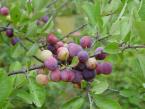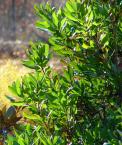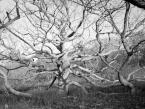I was thinking the other day about an old friend, conservationist Rusty Walton, who died last year. To say he was quiet would be an understatement. I could rarely make a smile bend on his face no matter how hard I tried. However, as I think back on the times I spent with him it always makes me smile. He was a dedicated naturalist and an accomplished ecologist. He introduced me to my first wild patch of wood lily on the Vineyard almost 10 years ago. Recently I went back to the same spot and, surprisingly, the lilies, like Rusty were gone. The wood lily (Lilium philadelphicum) has been drastically reduced on the Vineyard by large populations of deer. Wood lily has a natural distribution range across 37 U.S. states. However similar to here on the Vineyard, they are losing ground across North America due to the over population of deer.
Frequently I am asked about what it means when a plant goes extinct. On the Vineyard I am talking about local extinction, not the complete loss of a species from our planet. The underlying tragedy of local species extinction is the loss of the co-dependent species that have formed a mutualistic (beneficial) relationship with plants. These species include its insect pollinators that use it as a nectar source, and insects that may also feed on parts of the plant or lay their eggs on it to support their life cycle. The dependence goes further with the birds that feed on those insects. Our local fauna (animal populations) are dependent on our local flora (plant populations). So losing a plant population creates a ripple effect, all culminating in a downward trend in biodiversity. When we lose a single species it does matter. The world becomes less diverse, less beautiful, and more and more homogenous. Overall, it means we are losing our biological heritage, and in some cases, we may not get it back.
Wood lily and its decline is just one story among many Island plant species losing the battle to deer browse. Another native lily, Turks cap lily, Lilium superbum has been nearly eaten to local extinction. The problem with an overabundance of deer is a human one. That is, the loss of natural areas to development or habitat fragmentation has caused deer to seek refuge in the only spots that remain, with us! While we dislike suburbanization off-Island, we have our own brand of it right here. When the choice is between charismatic species like deer and beautiful lilies, deer win every time. Can deer, humans and lilies co-exist? Yes, within a balanced framework, where the numbers of one species does not mean the elimination of another.
Deer belong on Martha’s Vineyard. They are part of the natural web of life here. However, at population densities as high as they are now, we have many rare plant species on a path to local extinction unless measures are enacted to lower the populations, not eliminate them entirely. What can a plant science institution do to protect local species? We can tell their story and we can map their populations on the Island to monitor their health. We also can grow these lilies and plant them in our fields. We can share the message of the importance of biodiversity, the sum total of life on earth.
Tim Boland is executive director of the Polly Hill Arboretum in West Tisbury.








Comments
Comment policy »